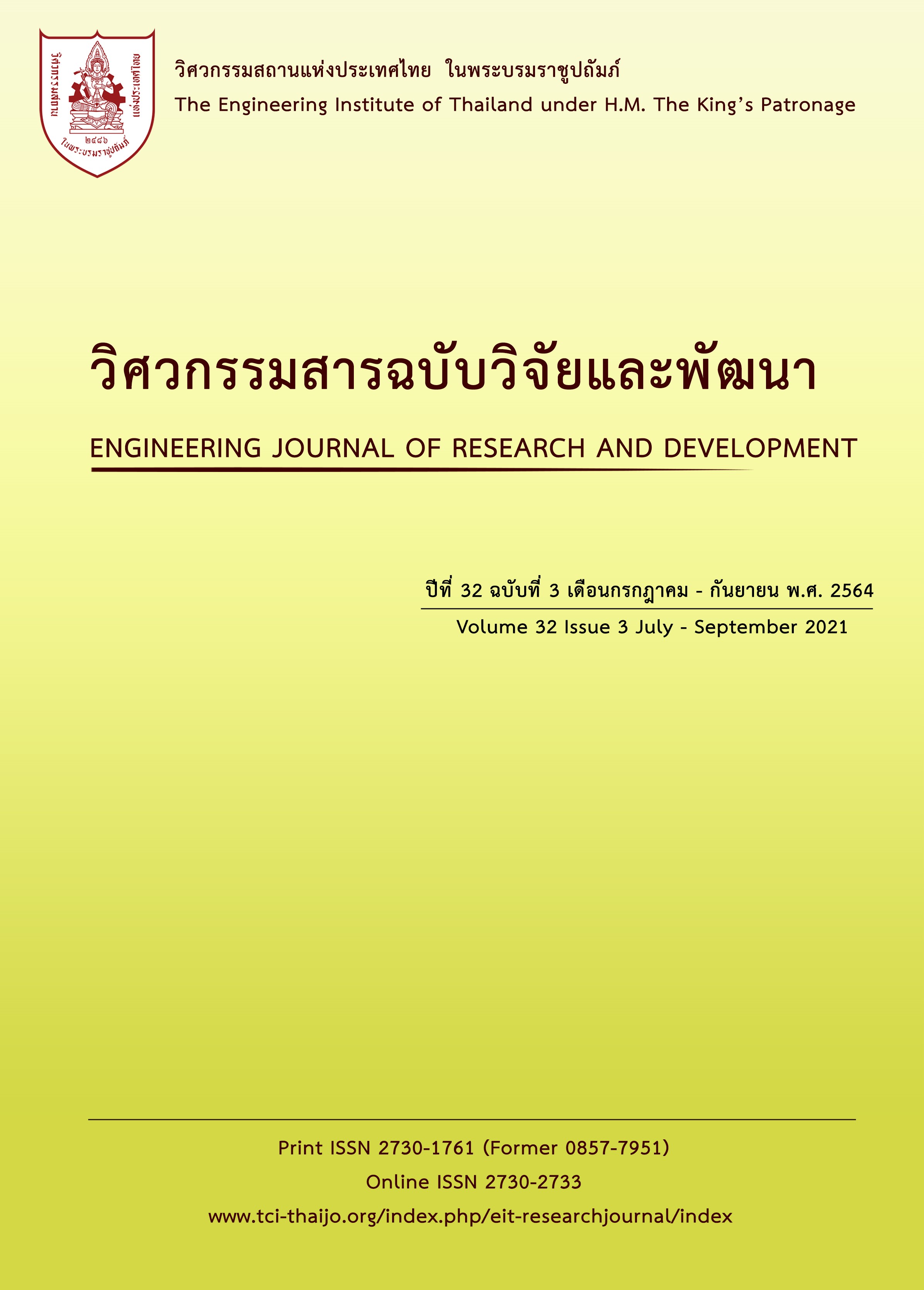Two-Dimensional Plane Stress Analysis by Smoothed Finite Element Method using 4 smoothing cells created by an arbitrary quadrilateral element
Main Article Content
Abstract
The cell-based smoothed finite element analysis for this research used the arbitrary quadrilaterals whose sides were randomly selected by defined as ratio of its original side. The values of were 0.2-0.3, 0.3-0.4 and 0.4-0.5 respectively. Smoothed strain field was created from gradient smoothing technique to distribute all strain field over entire smoothing domains. Symmetrical concept called “Semi-unit cell” has been applied to establish pattern providing the continuity for the entire problem domain. Two-dimensional plane stress problem investigated was cantilever beam subjected to parabola traction at the end. To determine tip displacements, normal and shear stresses over cross-sectional area of benchmark problem at the middle span, meshing was considered to be 16x4, 24x6, 32x8, 40x10 and 48x12 respectively. The percentage differences, at both maximum value of and mesh size, between tip displacement, normal stress and shear stress compared to the exact solutions were 0.78, 0.04 and 1.52 respectively.
Article Details
The published articles are copyright of the Engineering Journal of Research and Development, The Engineering Institute of Thailand Under H.M. The King's Patronage (EIT).
References
Bathe K-J. Finite element procedures, Prentice hall. New Jersey. 1996.
Zienkiewicz OC, Taylor RL, Zhu JZ. The finite element method: its basis and fundamentals: Elsevier; 2005.
Hughes TJ. The finite element method: linear static and dynamic finite element analysis, Courier Corporation, 2012.
Liu, G.; Trung, N.T. Smoothed Finite Element Methods, CRC Press: Boca Raton, FL, USA, 2010.
Liu, G.R.; Dai, K.Y.; Nguyen, T.T. A smoothed finite element method for mechanics problems. Comput. Mech. 2007, 39, pp.859–877.
Dai K, Liu G, Nguyen T. An n-sided polygonal smoothed finite element method (nSFEM) for solid mechanics. Finite elements in analysis and design. 2007, 43(11-12), pp.847-60.
Liu G, Nguyen-Xuan H, Nguyen-Thoi T, Xu X. A novel Galerkin-like weak form and a superconvergent alpha finite element method (SαFEM) for mechanics problems using triangular meshes. Journal of Computational Physics. 2009, 228(11), pp.4055-87.
Liu G, Zhang G. A normed G space and weakened weak (W2) formulation of a cell-based smoothed point interpolation method. International Journal of Computational Methods, 2009, 6(01), pp.147-79.
Hamrani A, Habib SH, Belaidi I. CS-IGA: A new cell-based smoothed isogeometric analysis for 2D computational mechanics problems. Computer Methods in Applied Mechanics and Engineering, 2017, 315, pp.671-690.
Wang D, Zhang H, Xuan J. A strain smoothing formulation for NURBS-based isogeometric finite element analysis. Science China Physics, Mechanics and Astronomy. 2012, 55(1), pp.132-140.
Bordas SP, Rabczuk T, Hung N-X, Nguyen VP, Natarajan S, Bog T, et al. Strain smoothing in FEM and XFEM. Computers & structures. 2010, 88(23-24), pp.1419-1443.
Nguyen‐Xuan H, Nguyen‐Thoi T. A stabilized smoothed finite element method for free vibration analysis of Mindlin–Reissner plates. Communications in Numerical Methods in Engineering. 2009, 25(8), pp.882-906.
Dai K, Liu G. Free and forced vibration analysis using the smoothed finite element method (SFEM). Journal of Sound and Vibration. 2007, 301(3-5), pp.803-820.
Natick, MATLAB. 9.7.0.1190202 (R2019b). Massachusetts, The MathWorks Inc.,2018.
Felippa CA. Introduction to finite element methods (Lecture note). University of Colorado. 2004.
Liu G-R. Meshfree methods: moving beyond the finite element method, Taylor & Francis, 2009.
Chen JS, Wu CT, Yoon S, You Y. A stabilized conforming nodal integration for Galerkin mesh‐free methods. International journal for numerical methods in engineering, 2001, 50(2), pp.435-466.
Liu G. A generalized gradient smoothing technique and the smoothed bilinear form for Galerkin formulation of a wide class of computational methods. International Journal of Computational Methods. 2008, 5(02), pp.199-236.
Timoshenko S, Goodier J. Theory of Elasticity, 3rd ed, McGraw-Hill. New York. 1970.


